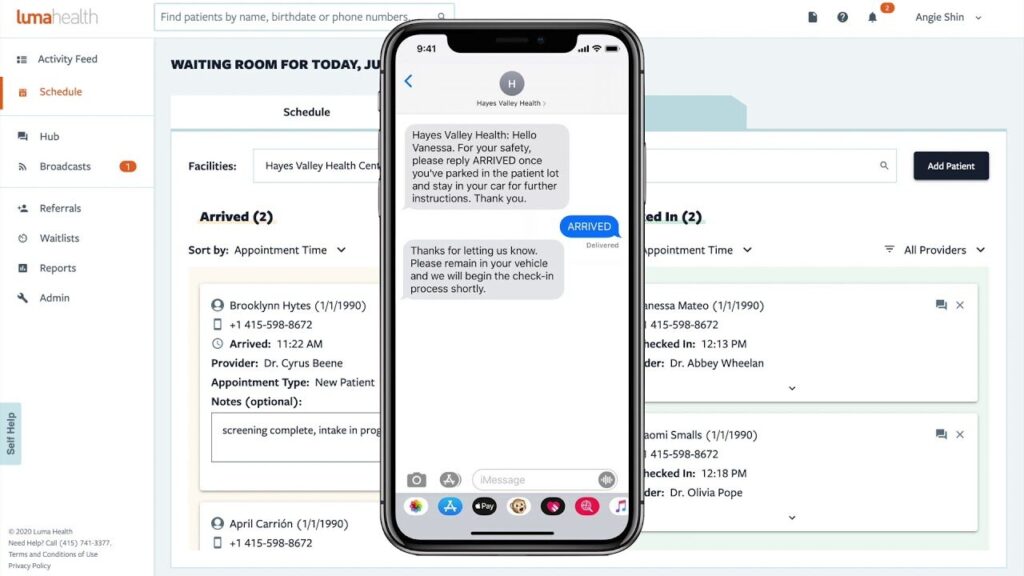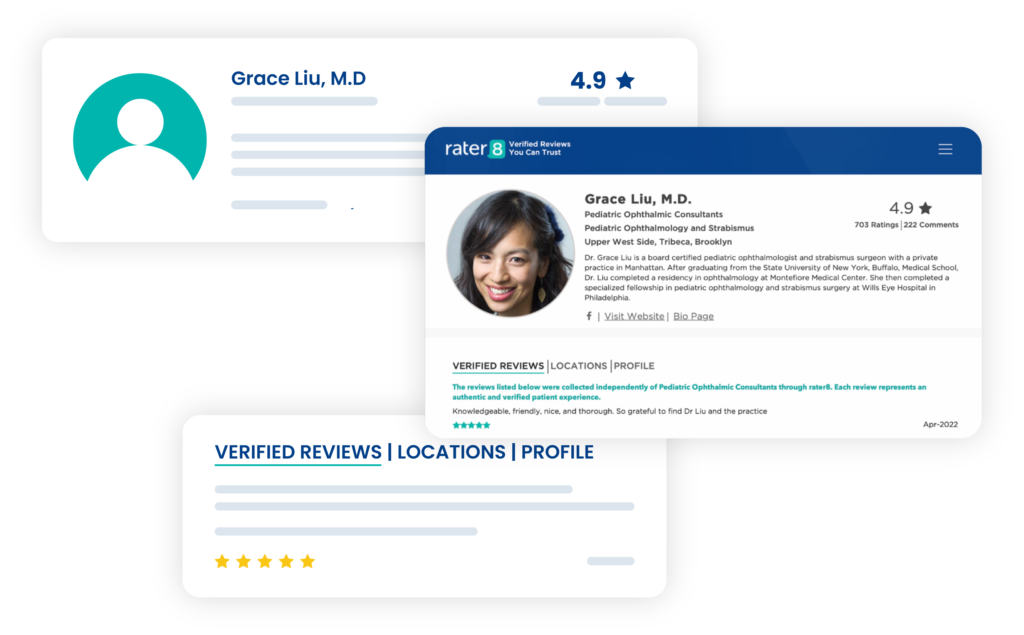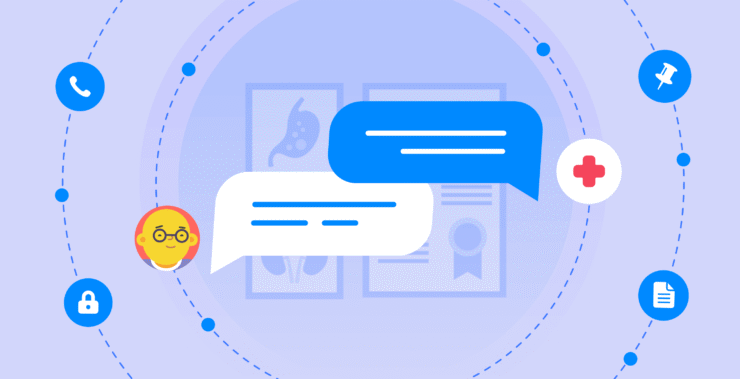Ever had a patient ghosting you after their first visit?
One moment they’re sitting in your office nodding along, and the next they’ve disappeared into thin air, leaving you wondering if they’d existed at all. Younger patients, meanwhile, seem to avoid in-person appointments like the plague, turning instead to Dr. Google or having ChatGPT diagnose that persistent cough and recommend a course of treatment according to a few vague symptoms.
And it’s not just frustrating – it’s costly. With the average cost of a single missed appointment estimated at around $200, these losses add up fast. For an independent practice, just two no-shows per day can translate into $150,000 or more in lost revenue annually.
This is the very reason patient engagement programs have become such a focal point of running a successful practice. Of course, neither Google nor AI tools are quite ready to replace real physicians. What starts as a harmless search can lead to panic, dangerous self-diagnosis, or overlooked warning signs that only a trained professional would recognize.
At the same time, physician-patient relationships are evolving. What used to be built up over time with office visits is now heading toward something faster, virtual, and more convenient. If that experience is not seamless or personalized, patients will not think twice about disappearing.
To protect your revenue, keep your schedule full, and turn first-time visitors into loyal patients, healthcare providers today need to adapt. Let’s explore strategies that help you connect, communicate, and build lasting trust.
What is patient engagement?
Patient engagement is more than simply sending reminder notices or handing out pamphlets. It’s a two-way relationship where patients are kept informed, active, and motivated throughout each stage of their care.
From first contact through follow-up post-visit, it’s a process that never ends. One that is based on open patient communication, personalized experiences, and the right digital tools to support both parties – patients and providers.
When engagement succeeds, patients aren’t simply seen. They are active partners in their care. And that is where actual improvement starts.
Why patient engagement strategies are more crucial than ever
So what are patient engagement strategies, then?
They’re the methods clinics use to attract, involve, and retain patients – before, during, and after care. From the first click on your booking page to follow-up texts, reminders, feedback surveys, and even the way your staff contacts behind the scenes. And that part is worth more than people give credit for. Tools like Chanty allow healthcare staff to remain on top of things, send updates easily, and share tasks without email strings or corridor chatter.
These strategies, online or face-to-face, robotic or individual, control the patient experience, and often determine whether they return or leave you high and dry after visit number one.
Because let’s get real: when something goes wrong, patients don’t necessarily complain. They vanish. They reschedule sessions, skip follow-up appointments, or fail to show up to begin with. For your business, that means time slots filled with nothing, lost revenue, and a damaged reputation that’s difficult to repair.
Today’s patients expect ease, speed, and a sense of control. They expect care to be as seamless as grabbing takeout – convenient, on-demand, and hassle-free. If it’s not, they won’t complain. They’ll simply leave.
That is why tools like digital patient engagement software matter. But before choosing platforms, it’s insightful to consider what exactly needs to be improved, and which portions of the care pathway are draining your time, trust, and patient loyalty away.
Stage 1: Acquisition
Acquisition comes before engagement. You can’t engage patients who never stepped foot in the door.
Online-first patients today want to gather as much information as possible before booking an appointment. This is especially true for Millennials, 51 % of whom visit a primary physician less than once per year and rely on peer reviews when choosing providers. They scan web reviews, compare convenience, and expect transparency prior to ever calling a provider. That means your patient acquisition strategy is not about being visible – it’s about frictionless access. Clinics that excel at this stage provide a seamless digital experience from discovery to booking.
That means:
- A mobile-responsive website
- Streamlined online booking
- Faster follow-up messages
- Clear pricing or insurance data
- And, most crucially, a stellar first impression in Google search
This is not new-age fluff – it actually makes a difference in long-term engagement. Patients who hit a brick wall before even showing up for their first appointment will never come back. And glacial intake processes? That’s how trust is torched before it’s ever been built.
Strong strategies blend healthcare knowledge with health technology. They know when to use what marketing channels, how to convert how many leads into bookings, and where they fall off. That’s why your CRM, booking software, and analytics integrations aren’t a nice-to-have-they’re a requirement.
Tools for patient acquisition
WebPT
WebPT
Originally built for physical therapy clinics, WebPT is now an end-to-end solution that helps healthcare businesses attract and manage patients. It has lead tracking, referral management, electronic intake forms, and analytics to help you understand how patients discover and engage with your clinic – before and after scheduling.
Relias
Relias
Relias is more staff and learning development, but it’s also offering data-driven insights that will support better acquisition. Its onboarding and patient satisfaction tools enable clinics to track gaps in communication and maximize engagement. If your front-end staff engages with the patient experience, Relias equips and aligns them for better performance.
Stage 2: Onboarding
Even a motivated patient will be gone from your practice if the intake process is a pain. Paper surveys, duplicate data entry, no confirmation – any of these can slow down when they need to get going.
That’s where patient intake software comes in. It simplifies data collection, e-signatures, and pre-visit surveys so patients feel taken care of instead of bogged down. No one likes to arrive early just to sign their name three times on a clipboard.
Alongside that, patient onboarding software plays an equally important, but quieter, role. Think:
- Softer reminders
- Walk-throughs for procedure prep
- Personalized welcome messages
It is a gentle one that sets up trust and confidence before the first face-to-face meeting. Clinics that get onboarding right reduce no-shows, improve satisfaction, and set a positive tone for care.
Patient onboarding tools
IntakeQ
IntakeQ
A robust platform built for digital patient intake. IntakeQ allows clinics to automate from HIPAA-compliant form collection to payment authorization and consent signatures. It includes conditional logic, pre-filled fields, and integration with top EHR systems – allowing staff to see more patients, fewer forms.
Jotform
Jotform
Jotform is widely recognized for its easy-to-use form builder, making it a go-to solution for patient intake in healthcare settings. Clinics and private practices rely on Jotform to create customizable, HIPAA-friendly forms for new patient registration, consent, and feedback. It helps streamline onboarding by capturing responses in real time and syncing them with other tools in your workflow.
For even more seamless coordination between front-desk intake and back-office communication, Jotform can be integrated with Chanty. This way, your team can instantly act on new submissions, assign tasks, and stay aligned – without switching platforms.
Stage 3: Early engagement
The first visit isn’t the finish line – it’s where the real work begins. And this is exactly where clinics often run out of steam.
Younger patients are the hardest to hold on to. Gen Z grew up with smartphones in hand. They can check anything, anywhere, in an instant. When it comes to their health, they don’t rely on just one source – they cross-check advice online, in apps, through social media, and sometimes even with their parents. That’s why, if they’ve chosen your clinic, it’s crucial to keep the connection alive. Not just during the visit, but after it. Every follow-up, every message, every check-in counts.
Without active communication, questions go unanswered. Medications are forgotten. Appointments slip through the cracks. And suddenly, you’re trying to get somebody back who has already drifted away – and that can have real consequences for their health.
That’s why early communication has to be intentional, clear, and convenient. Digital patient engagement tools make it easier:
- Post-visit follow-ups
- Appointment reminders
- Medication reminders
- Two-way messaging for questions or clarifications
Done right, this isn’t just checking a box – it’s trust-building at scale. For patients with long-term or complex care, a care management system keeps progress visible, schedules follow-ups, and gives everyone a clear sense of what comes next.
Tools that support early engagement
Luma Health

LumaHealth
Luma Health is a specialist in keeping communication flowing following the first visit. With smart reminders to two-way texting in real-time, it enables clinics to automate follow-ups, reschedule, and reach patients in the type of responsiveness they have come to expect from online businesses.
Klara
Klara
Klara offers one platform for communication that closes the gap among patients, providers, and staff by getting everyone into one HIPAA-covered inbox. It permits texting, voice, and file sharing – all without patients having to download an app. This facilitates easy staying connected and maintains the initial engagement process easy and familiar.
Stage 4: Internal coordination
You can have the best intake process and a perfect EHR – but if your team isn’t on the same page, the patient will feel it.
Delays, asking for the same information twice, confusing instructions – these aren’t usually the result of bad care, but of disconnected teams. That’s why frictionless internal coordination isn’t a “back office” issue. It directly affects the patient’s experience.
To deliver truly patient-centric care, front-office personnel, nurses, physicians, and billing departments must be able to pass on updates, flag issues, and resolve questions in real time. This is where healthcare team collaboration software enters the picture. It is not just messaging – it is frictionless collaboration.
Tools that facilitate coordination
Chanty
Chanty
Chanty is a feature-rich and swift internal communication software for clinics that unifies HiIPAA-compliant team chat, voice/video calls, task management, and file sharing in one place. It’s simplicity itself – no noise, no mess – and easily integrates with systems you already know and use. With voice message capability, role-based permissions, and @mentions, Chanty gets everyone from reception to radiology on the same page. Teams can create dedicated channels for departments or cases, reducing chaos and boosting accountability.
TigerConnect

TigerConnect
TigerConnect is a secure clinical collaboration platform for hospitals and large practices. It features HIPAA-compliant texting, on-call schedules, and signal that cuts through the noise. In high-urgency settings, it delivers the right message to the right person without delay.
Stage 5: Engaged over the long term
Engagement doesn’t conclude with the end of the appointment. This is really where long-term relationships start.
Patients don’t merely want reactive care – they anticipate updates, reminders, and beneficial health advice individualized to their needs. Without proactive outreach, even satisfied patients drop out of sight. This is where patient engagement software comes in handy: helping providers maintain meaningful connections with minimal effort.
The goal is to build trust between appointments. Not through spammy emails or generic newsletters – but through thoughtful communication, delivered through the right channels at the right time.
Tools that forge patient relationships
Spruce Health
Spruce Health
Spruce is a secure two-way communication platform for patients and care teams. It includes texting, video visits, and shared inboxes that allow follow-up to be personal and intuitive. You can leverage it for quick check-ins, pre-visit preparation, or ongoing care coordination. It’s also ideal for private practices and behavioral health where relationship building is crucial.
Stage 6: Feedback and improvement
Engagement is a two-way process. To truly improve the patient experience, clinics must not only communicate – but listen as well. But healthcare professionals too often treat feedback as an afterthought or hear it so late that they can no longer make a difference.
That is where patient feedback software comes in. It captures insights in real-time – after the visit, during treatment, or when something has gone wrong. Top platforms transform raw feedback into trends, alerts, and to-do’s.
By answering quickly to feedback, providers show patients their voices matter. This creates loyalty, drives improvements, and ultimately leads to improved care.
Software that closes the feedback loop
Qualtrics XM for Healthcare
Qualtrics XM
Qualtrics assists healthcare teams in collecting structured feedback at each patient touchpoint. Surveys can be event-triggered (e.g., post-discharge or post-telehealth appointment). The analytics of the platform uncover patterns – such as what leads to dissatisfaction or what brings patients back.
rater8

rater8
rater8 is a patient feedback platform designed to help healthcare providers collect and analyze real-time patient reviews. It automates post-visit surveys via text or email, capturing feedback immediately after appointments. The platform’s analytics highlight trends in patient satisfaction, identify high-performing providers, and reveal areas needing improvement – helping practices strengthen their reputation and enhance the overall patient experience.
Wrapping up: patient engagement Is a journey – not a feature
What engaged patients don’t suddenly appear. They’re grown – through thoughtful acquisition, effortless onboarding, conscientious support, and ongoing follow-up. Every step in this journey requires more than good intentions: it requires the proper technology and the proper internal processes.
Healthcare organizations that adopt platforms for intake, education, communication, and feedback don’t just make patient life easier. They also empower their own staff to get more done behind the scenes.
Want to keep your staff truly connected throughout every stage of patient care?
Chanty can help. Our HIPAA-compliant team messaging platform streamlines communication, unites workflows, and enables staff to respond fast – without the chaos of overflowing inboxes or outdated portals.
Book a demo today to see how Chanty can transform your internal communication.
Because when your team communicates effectively, your patients feel it – and that’s where meaningful engagement begins.








